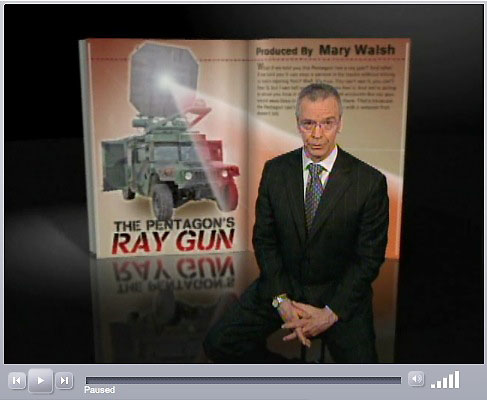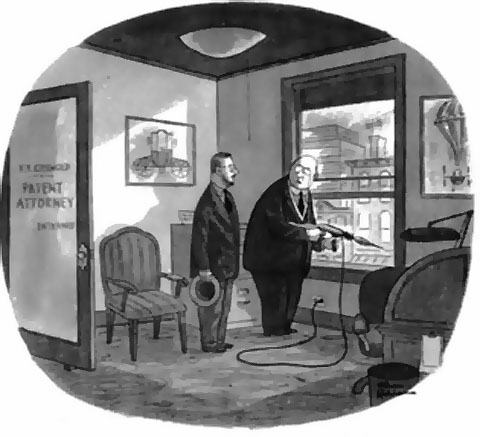SUBJECT: DEATH RAYS IN AMERICA
SOURCE: JUAN WISON juanwilson@mac.com
POSTED: 4 MARCH 2008 - 12:00pm HST
US might use ray guns against civilians

video above: click to watch www.cbsnews.com/sections/i_video/main500251.shtml?id=3897986n
by Juan Wilson on 4 March 2008 It was titled "The Pentagon's Ray Gun" and was produced by Mary Walsh. David Martin reported on the status of a "non-lethal" weapon straight out of Buck Rogers. You can watch the segment by clicking on the image (or link) above. CBS was a blatant shill for Raytheon's PR message to get its product into the field. Raytheon is the developer of this "ray gun". The gist of the article was that the Pentagon has been dragging its feet and underfunding (only $300,000,000) a new directed energy technology that could be in the field today arrayed against our enemies. It's called the Active Denial System (ADS). The new ADS technology is basically a heat wave similar to microwave radiation, that is directed by a parabolic dish at people. The advocates of the program stress that this is a "non-lethal" weapon that can be used to save lives. The case made was that a weapon that could make you as uncomfortable as being soaked in scalding hot water would deter bad behavior before lives were lost. The CBS segment interviewed those responsible for moving the program through the red tape of the Pentagon and showed the effect of the weapon on people. The demonstration included a simulated confrontation between US troops and an enemy. The Darker Side: Part I On the other side of the field was a group of uniformed US combat troops carrying automatic weapons. They confronted a group of "demonstrators" dressed in civilian clothing. The demonstrators carried signs saying things like; "World Peace", "Peace Not War, "Make Love Not War", "Free Speech", "Hug Me", etc. The crowd chanted "Go home!", "Get out of our country!", and "We will not leave! You leave!" The uniformed soldiers pointed their guns at the demonstrators. The demonstrators did not disperse. Some demonstrators used "mock rocks" (maybe paper-mache) and tossed them at the soldiers. The soldiers retreated to a position out of the line of fire from the Hummer with the ADS. From a half a mile away the demonstrators were then subjected to the 100,000 watt ADS heat beam... for real. This was where the segment began looking like a local news Taser demonstration. The ray gun beam hit the demonstrators and they fell back as the invisible heat punch landed. The pain was instantly obvious, as if the demonstrators were struck with an object or electrically shocked. No one could bear to stay in the beam for more than a second or two. It certainly was non-lethal. After a few seconds the beam was shut down and everybody was okay. They tried over a few more times. It is interesting who the Pentagon perceives as an enemy: People that want world peace and and freedom, demanding that the US military get out of their country. The Darker Side: Part II Sue Payton is an Assistant Secretary of the Air Force. She is an advocate within the Pentagon for the ADS program. She had the ADS system tested on herself. The technicians involved with the test dialed the wallop of the system down on her. It incapacitated her. When she found out that she got only a partial dose, she asked to feel the real deal, and was even more impressed. What this tells me is that although this technology can be effective as a non-lethal weapon, that it has a range of energy and possible inflicted injury that can be dialed up or down. I cannot imagine that Raytheon has not thought to test what would be lethal levels of energy with the ADS just to see what would happen .I was reminded of the Charles Adams cartoon in a 1950's New Yorker magazine. A patent attorney is unimpressed with the effect on the crowded streets below as he tries the inventor's "death ray" on them. See below.
"Death Ray fiddlesticks. It doesn't even slow them down!"
The PMRF's Directed Energy Laser Weapons Program will be chemical lasers which use hydrogen fluoride, a corrosive material which can be made to release a powerful burst of infrared radiation. The laser can be focused and aimed as a weapon (death ray). These lasers can focus at least 25 megawatts of energy that could destroy a missile 2,000 miles away. For the scale of this realize 25 megawatts is half the electrical power generating capacity of Kauai. The firing of this weapon also destroys the lasing device and contaminates its site with hydrogen fluoride. A thousand foot radius danger zone, that could close the state park, will persist for days. What have we come to? Couldn't we be working on renewable energy instead of directed energy? Pentagon gets heat ray, version 2 by Jonathan Skillings on 12 September 2007 at C-Net News The heat rays go marching one by one by...well, that's about it for now. Raytheon said Tuesday that its Active Denial System 2 is now in the hands of the customer, the U.S. Air Force. Should it ever get beyond the evaluation stage, the ADS technology could be one of the very first directed-energy weapons fielded by the military. It looks like a satellite dish, works something like a microwave, and isn't supposed to cause any lasting harm.Active Denial System 2 has been delivered to the U.S. Air Force. What it's intended to do is beam short bursts of millimeter waves (which are smaller than the better-known microwaves) at a suspicious or unruly target--a crowd gathered outside a U.S. embassy, say--and make make the recipients scatter because they can't stand the heat. Literally. The ADS, which operates at 95GHz, causes an intense but skin-deep burning sensation that lasts only as long as a person is in the way of the beam, which in tests so far has been a matter of just a few seconds at most. Version 2 is an upgrade of the earlier system. It's bigger, more rugged and handles warmer atmospheric temperatures better, Raytheon says. And that version number is also pretty much the number of the systems that have been built so far: Raytheon has tallied up just one unit in each of the phases. ADS 0 was the initial technology demonstrator, and ADS 1 was mounted on a Humvee for further tests and for public demonstrations. ADS 2 is designed to be mounted on a variety of vehicles or to operate from a fixed site. What happens next with ADS 2 is up to the Pentagon, specifically its Joint Non-Lethal Weapons Program, for which the Air Force is the lead service. But the decisions on when, how and even whether to deploy are political as much as they are technical--ADS may be nonlethal, but the Pentagon surely isn't eager to see headlines like "U.S. fries protesters with energy weapon." Raytheon, meanwhile, has a smaller version called Silent Guardian, at one-third the size and one-third the power, that it says is available to interested buyers. Better hurry, though. There's just one of these, too. New Active Denial System = Next iPod? A smaller version using different technology and which probably looked like the one at right was developed as part of Project Sheriff. This would have fitted into a Stryker vehicle, and would have been deployed to Iraq; unfortunately it did not come up to scratch.(A number of people stressed to me that that the smaller system was significantly different to the larger one.)
|
see also:
TGI Article #12: The Navy's Plan for the Pacific 9/3/07
Island Breath: Navy Expansion Plan for PMRF 8/7/07
TGI Article #24: The Privitization of Hawaii 2/8/08
Island Breath: Militarism in Hawaii 5/17/07
